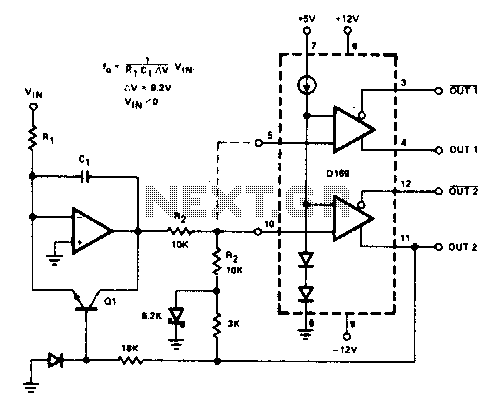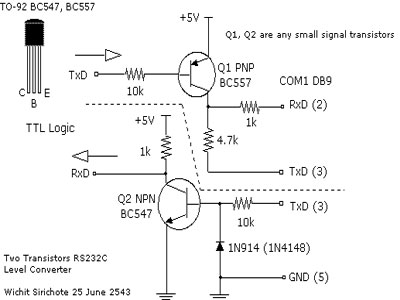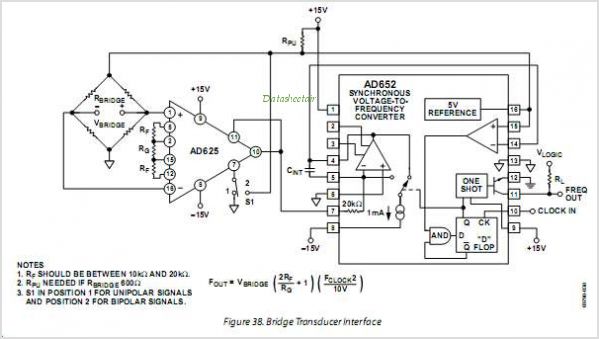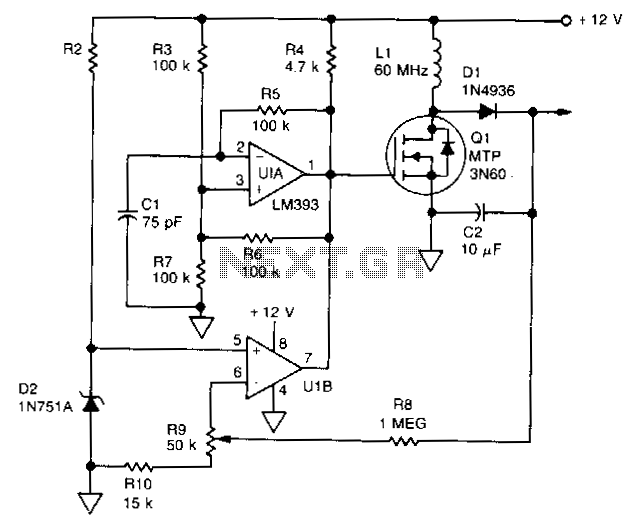
RMS to DC Converter
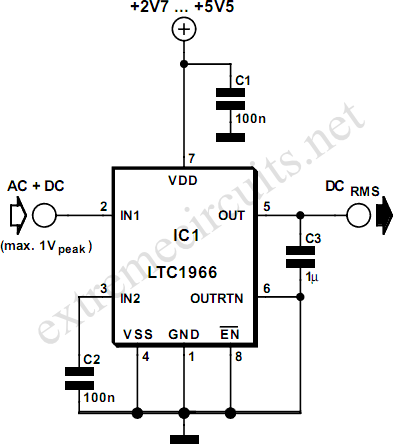
To measure the RMS value of an alternating voltage, an accurate converter is necessary to produce the true RMS value of its alternating input as a DC output. For simple sine-wave inputs, the RMS voltage can be calculated as 0.707 times the peak AC voltage; however, this calculation becomes more complex with non-sinusoidal waveforms. The RMS value is defined as the DC voltage that would produce the same heating effect in a resistor as the alternating voltage. The LTC1966 from Linear Technology employs a new form of delta-sigma conversion and is designed for battery operation, consuming only 170 µA from the supply. This new technique achieves an accuracy of 0.02% between 50 mV and 350 mV and exhibits high linearity. It operates from 50 Hz to 1 kHz with an error of 0.25% and can function up to 6 kHz with a 1% error. The input voltage range on the differential inputs IN1 and IN2 extends to the supply rails, allowing the voltage on IN1 to swing between 0 V and the supply voltage in the non-symmetrical circuit presented. If the signal to be measured is purely AC, an additional coupling capacitor will be necessary. The input impedance is in the megohm range. The output voltage at the OUT pin can be adjusted by applying a DC voltage to the OUTRTN pin, which is particularly useful when interfacing with LCD multimeter ICs like the 7106. A further capacitor is connected to the output, which is charged to the required voltage by the switched-capacitor circuit within the converter. This capacitor is ten times smaller than those required by previous RMS to DC converter designs. The LTC1966 is not sensitive to temperature variations and is available in an 8-pin MSOP package, allowing for the construction of a compact RMS to DC converter using only four components.
The LTC1966 is a highly efficient and precise device ideal for applications requiring accurate measurement of RMS values in various AC signal conditions. Its delta-sigma conversion technology ensures that even complex waveforms can be processed with minimal error, making it suitable for a wide range of electronic measurement applications. The low power consumption of 170 µA makes it particularly advantageous for battery-operated devices, extending battery life while maintaining measurement accuracy.
The device's ability to handle input voltages across the supply rails enhances its versatility, allowing it to be integrated into various circuit designs without the need for additional components to limit input voltage. This feature is particularly beneficial in applications where the input signal may vary significantly, ensuring reliable operation across different conditions.
The high input impedance of the LTC1966 minimizes loading effects on the signal source, preserving the integrity of the measured signal. Coupling capacitors can be employed to isolate the AC signal and prevent DC offset issues, ensuring that the RMS value accurately reflects the true power of the alternating signal.
The adjustable output voltage capability through the OUTRTN pin allows for seamless integration with other measurement systems, such as LCD multimeters. This adaptability is crucial in designing user-friendly measurement devices that require precise output scaling.
In summary, the LTC1966 represents a significant advancement in RMS to DC conversion technology, providing high accuracy, low power consumption, and compact design, making it an excellent choice for engineers and designers in the field of electronic measurement.In order to measure the RMS value of an alternating voltage an accurate converter is required to produce the true RMS value of its alternating input as a DC output. With simple sine-wave inputs the RMS voltage can simply be calculated as 0. 707 times the peak AC voltage, but with complex waveforms the calculation is not nearly as straightforward.
T he RMS value is defined as the DC voltage that would give the same heating effect in a resistor as the alternating voltage. The LTC 1966 from Linear Technology ( uses a new form of delta-sigma conversion and is designed for battery operation, drawing only 170 µA from the supply.
The new technique is accurate to 0. 02 % between 50 mV and 350 mV and is highly linear. It can operate from 50 Hz to 1 kHz (with an error of 0. 25 %) and up to 6 kHz with a 1 % error. The input voltage range on the differential inputs IN1 and IN2 extends to the supply rails, and so in the non-symmetrical circuit shown here the voltage on IN1 can swing between 0 V and the supply voltage. If the signal to be measured is AC only, then another coupling capacitor will be required. The input impedance is many megohms. The output voltage at the OUT pin can be offset by applying a DC voltage to the OUTRTN pin. This is particularly helpful when using the device with LCD multimeter ICs such as the 7106. A further capacitor is connected to the output which is charged up to the required voltage by the switched-capacitor circuit in the converter.
The capacitor required is ten times smaller than that demanded by previous RMS to DC converter designs. The LTC1966 is not temperature sensitive and is available in an 8-pin MSOP package. It allows a tiny RMS to DC converter to be constructed using just four components. 🔗 External reference
The LTC1966 is a highly efficient and precise device ideal for applications requiring accurate measurement of RMS values in various AC signal conditions. Its delta-sigma conversion technology ensures that even complex waveforms can be processed with minimal error, making it suitable for a wide range of electronic measurement applications. The low power consumption of 170 µA makes it particularly advantageous for battery-operated devices, extending battery life while maintaining measurement accuracy.
The device's ability to handle input voltages across the supply rails enhances its versatility, allowing it to be integrated into various circuit designs without the need for additional components to limit input voltage. This feature is particularly beneficial in applications where the input signal may vary significantly, ensuring reliable operation across different conditions.
The high input impedance of the LTC1966 minimizes loading effects on the signal source, preserving the integrity of the measured signal. Coupling capacitors can be employed to isolate the AC signal and prevent DC offset issues, ensuring that the RMS value accurately reflects the true power of the alternating signal.
The adjustable output voltage capability through the OUTRTN pin allows for seamless integration with other measurement systems, such as LCD multimeters. This adaptability is crucial in designing user-friendly measurement devices that require precise output scaling.
In summary, the LTC1966 represents a significant advancement in RMS to DC conversion technology, providing high accuracy, low power consumption, and compact design, making it an excellent choice for engineers and designers in the field of electronic measurement.In order to measure the RMS value of an alternating voltage an accurate converter is required to produce the true RMS value of its alternating input as a DC output. With simple sine-wave inputs the RMS voltage can simply be calculated as 0. 707 times the peak AC voltage, but with complex waveforms the calculation is not nearly as straightforward.
T he RMS value is defined as the DC voltage that would give the same heating effect in a resistor as the alternating voltage. The LTC 1966 from Linear Technology ( uses a new form of delta-sigma conversion and is designed for battery operation, drawing only 170 µA from the supply.
The new technique is accurate to 0. 02 % between 50 mV and 350 mV and is highly linear. It can operate from 50 Hz to 1 kHz (with an error of 0. 25 %) and up to 6 kHz with a 1 % error. The input voltage range on the differential inputs IN1 and IN2 extends to the supply rails, and so in the non-symmetrical circuit shown here the voltage on IN1 can swing between 0 V and the supply voltage. If the signal to be measured is AC only, then another coupling capacitor will be required. The input impedance is many megohms. The output voltage at the OUT pin can be offset by applying a DC voltage to the OUTRTN pin. This is particularly helpful when using the device with LCD multimeter ICs such as the 7106. A further capacitor is connected to the output which is charged up to the required voltage by the switched-capacitor circuit in the converter.
The capacitor required is ten times smaller than that demanded by previous RMS to DC converter designs. The LTC1966 is not temperature sensitive and is available in an 8-pin MSOP package. It allows a tiny RMS to DC converter to be constructed using just four components. 🔗 External reference
